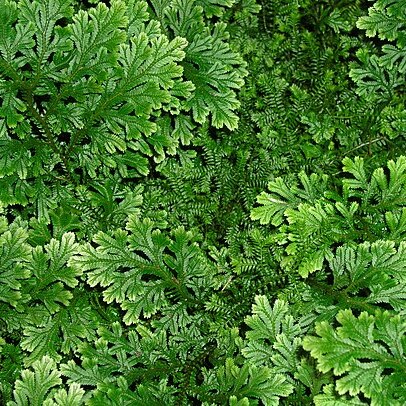Plants herbaceous, annual or perennial, sometimes remaining green over winter. Stems leafy, branching dichotomously, regularly or irregularly forked or branched, protostelic (sometimes with many protosteles or meristeles), siphonostelic, or actino-plectostelic. Rhizophores (modified leafless shoots producing roots) present or absent, geotropic, borne on stems at branch forks, throughout, or confined to base of stems. Leaves on 1 plant dimorphic or monomorphic, small, with adaxial ligule near base, single-veined [rarely veins forked]. Strobili (clusters of overlapping sporophylls) sometimes ill-defined, terminal [lateral], cylindric, quadrangular, or flattened. Sporophylls (fertile leaves) monomorphic or adjacently different, slightly or highly differentiated from vegetative (sterile) leaves. Sporangia short-stalked, solitary in axil of sporophylls, opening by distal slits. Spores of 2 types (plants heterosporous), megaspores (1--2--)4, large, microspores numerous (hundreds), minute.
Perennial (rarely annual) terrestrial (occasionally epiphytic) herbs. Rhizome erect and rooted at the base, or scrambling, prostrate, or creeping; some species bearing dichotomously branched often aerial solitary rhizophores throughout. Branches usually repeatedly dichotomous, sometimes appearing pinnate. Leaves monomorphic or dimorphic, ±herbaceous, decussate or spirally arranged, very small, simple, ±sessile, with a single inconspicuous vein. Sporophylls usually terminal on primary stem and branches, frequently clustered into a distinct strobilus or spike. Sporangia borne singly in the axils of sporophylls, of 2 kinds, variously arranged; megasporangia assuming the shape of the 4 developing megaspores; microsporangia globose to reniform, containing numerous microspores. Megaspores trilete, 200–800 µm diam., pale buff or white (when dry), usually rugose-reticulate. Microspores trilete, 20–60 µm diam., orange-brown to red, echinate to strongly rugose.
Annual or perennial terrestrial herbs. Stems erect, prostrate or occasionally climbing, usually bearing aerial roots (rhizophores); branching often regular, ± in one plane giving a frond-like appearance. Leaves ligulate, small, numerous, ± uniform and spirally arranged or wider and unequal in two ranks, those facing outwards smaller (median leaves) and those below on either side larger (lateral), often variously aristate and ciliate
Leaves ligulate, small, numerous, heteromorphous (at least on the branches), those of the lower plane lateral, spreading, those of the upper plane superficial, directed forwards; the leaves in the axils of the branches differ from the lateral leaves and are normally equal–sided
Stems erect or prostrate, bearing rhizophores
Herbs, terrestrial, annual or perennial


